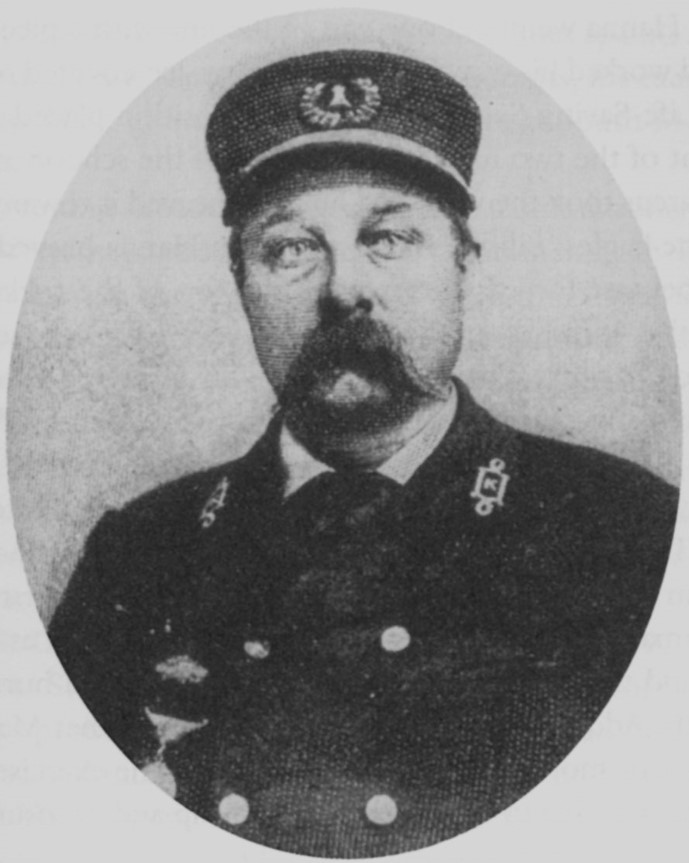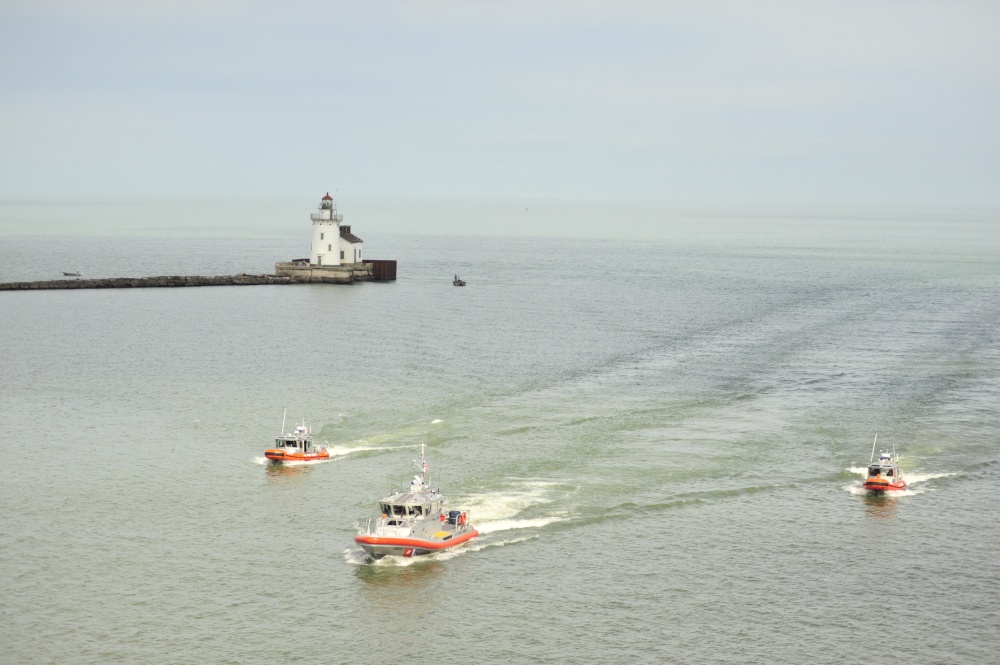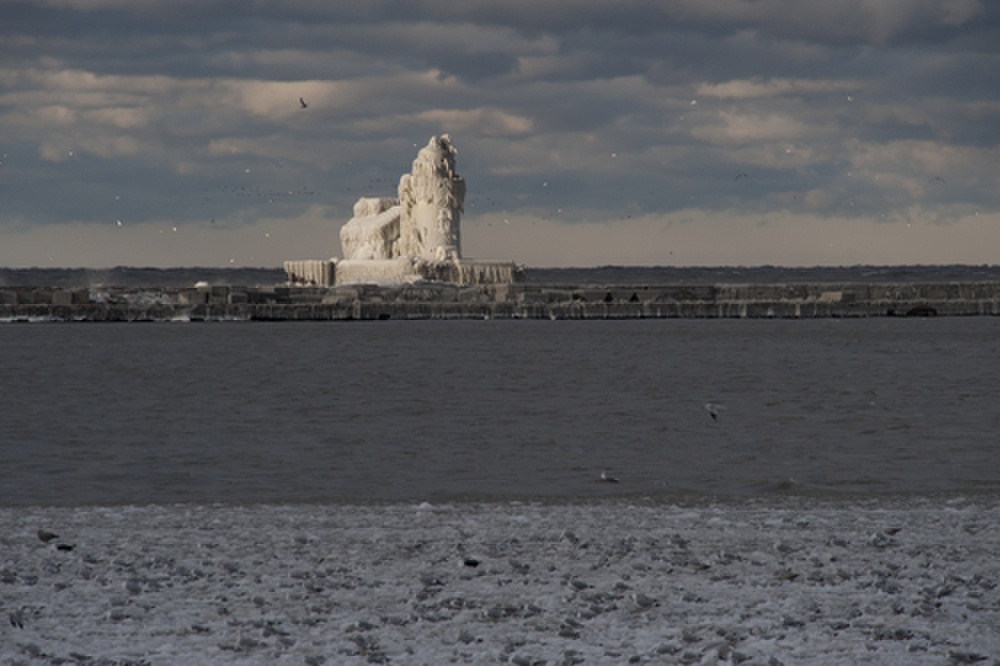 On Nov. 18, 1884, after serving three years at the U.S. Life-Saving Service station in Cleveland, Frederick Hatch accepted the position of assistant keeper with the U.S. Lighthouse Service at the Cleveland Lighthouse on Water Street. Just a year later, on Oct. 20, 1885, following his tour of duty as assistant keeper, Hatch was promoted to Keeper of the Cleveland Breakwater Lighthouse. Hatch’s second Gold Lifesaving Medal rescue occurred during his service as keeper of the Cleveland Light.
On Nov. 18, 1884, after serving three years at the U.S. Life-Saving Service station in Cleveland, Frederick Hatch accepted the position of assistant keeper with the U.S. Lighthouse Service at the Cleveland Lighthouse on Water Street. Just a year later, on Oct. 20, 1885, following his tour of duty as assistant keeper, Hatch was promoted to Keeper of the Cleveland Breakwater Lighthouse. Hatch’s second Gold Lifesaving Medal rescue occurred during his service as keeper of the Cleveland Light.
The night of Oct. 26, 1890, was dark and stormy. Towing the lumber laden schooner barge Wahnapitae of Port Huron, Michigan, the steamer John M. Nicol of Detroit, attempted to reach the safety of Cleveland Harbor. The storm caused the steamer to lose control of the tow and the barge drifted toward the breakwater about a half-mile from the Cleveland Harbor Lifesaving Station, Keeper Hatch’s former employer. There were eight people on the drifting schooner barge, including the captain’s wife.
The barge towline was cast off and the steamer Nicol proceeded into the harbor while the Wahnapitae dropped anchor just off the breakwater. Two harbor tugboats, the Tom Maytham and H.L. Chamberlin, attempted to get towlines to the Wahnapitae, however, they were unsuccessful and the barge dragged anchor until it crashed against the east end of the west breakwater. The barge became a complete wreck. The Wahnapitae’s crew jumped onto the breakwater and made their way toward Keeper Hatch’s lighthouse located about 100 feet from the barge. With Hatch’s assistance, some of them succeeded in reaching shelter, but others were less fortunate.
The Cleveland Harbor Lifesaving Station lookout observed the arrival of the tugs to tow the Wahnapitae. Noting that the schooner was dragging toward the breakwater, Keeper Charles Goodwin ordered his crew to launch its lifeboat and the boat was already en route by the time the tugs signaled for assistance. Upon reaching the wreck, Keeper Godwin realized he could only approach the barge from the windward side, however, any attempt to board it would result in the destruction of the lifeboat. Goodwin decided to turn the boat about and seek shelter in the lee of the breakwater.
Meanwhile, Lighthouse Keeper Hatch jumped into his own boat and rowed under the lee of the breakwater, picking up the captain’s wife and one of the seamen. Hatch rowed back to the lighthouse, where a huge wave burst over the breakwater and capsized the boat sending Hatch and his two passengers into the water. Fortunately, Hatch had taken the precaution of attaching one end of a small line to the crib-work near the tower and dropped the other end into his boat. When his boat overturned, Hatch grasped the line pulling himself and the woman to a nearby ladder. They climbed the ladder and rushed to the safety of the lighthouse. The sailor who capsized with them made it to the ladder where he clung to safety.
There, inside the breakwater, Station Keeper Goodwin found the tugs rescuing schooner victims who were washed off the breakwater. Each of the tugs picked up one man, but a third man was drowned before either tug could reach him. Seeing the man still clinging to the ladder inside the breakwater, Goodwin steered the lifeboat alongside the victim and rescued him just as another wave broke over the breakwater swamping the boat.
a third man was drowned before either tug could reach him. Seeing the man still clinging to the ladder inside the breakwater, Goodwin steered the lifeboat alongside the victim and rescued him just as another wave broke over the breakwater swamping the boat.
After a fruitless search for the remaining shipwrecked crew, Keeper Goodwin hailed the tugs to learn how many they had saved. Goodwin and his surfmen then rowed to the lighthouse to make inquiries there. Keeper Hatch informed Goodwin that he had rescued four survivors, including the captain and his wife. Finding no others in the water, Keeper Goodwin and the lifeboat crew returned to the station with the man they had rescued. On their way, the tugs landed their two rescued men at the lifesaving station and all survivors were provided hot food and dry clothes. Early the next morning, on Oct. 27th, the lifesaving crew launched their lifeboat and pulled to the breakwater to bring ashore the survivors at the lighthouse that Hatch had saved.
Leaving the safety of the lighthouse and running onto the breakwater, Hatch had performed heroic work in aiding the storm victims. He assisted a number of them to the shelter of the light tower, but towering breakers prevented him from reaching the rest of the victims. Lighthouse Keeper Hatch received a Gold Lifesaving Medal bar attachment (to his previously awarded Gold Medal) Feb. 26, 1891, for heroically rescuing the barge captain’s wife.
 On Sept. 15, 1895, after the 1892 discontinuation of the main Cleveland Lighthouse, the Lighthouse Service consolidated management of all Cleveland area lights into a single command. Hatch was placed in charge of two assistant keepers to oversee the Cleveland West Breakwater East End Lighthouse, Cleveland East Breakwater West End Lighthouse, Cleveland East and West Breakwater Pierhead Lights, and Cleveland East and West Pier Lights. Hatch’s duties included managing the staff, the maintenance and operation of six lights (including two 4th-order Fresnel lenses, one 6th-order Fresnel lens, and three lens lanterns), a steam-powered fog signal, a fog bell, as well as dwellings and grounds. It was an overwhelming responsibility for one man, especially with high levels of coal dust generated by Cleveland’s coal shipping piers that coated all surfaces of the lighthouses and the keeper’s quarters.
On Sept. 15, 1895, after the 1892 discontinuation of the main Cleveland Lighthouse, the Lighthouse Service consolidated management of all Cleveland area lights into a single command. Hatch was placed in charge of two assistant keepers to oversee the Cleveland West Breakwater East End Lighthouse, Cleveland East Breakwater West End Lighthouse, Cleveland East and West Breakwater Pierhead Lights, and Cleveland East and West Pier Lights. Hatch’s duties included managing the staff, the maintenance and operation of six lights (including two 4th-order Fresnel lenses, one 6th-order Fresnel lens, and three lens lanterns), a steam-powered fog signal, a fog bell, as well as dwellings and grounds. It was an overwhelming responsibility for one man, especially with high levels of coal dust generated by Cleveland’s coal shipping piers that coated all surfaces of the lighthouses and the keeper’s quarters.
Frederick Hatch served his exhausting Cleveland assignment for nearly 20 years. In March 1914, at the age of 55, he was transferred to the East and West Breakwater Lights in Lorain, Ohio. Hatch continued to serve in Lorain until Sept. 30, 1919, when he was dismissed from the Lighthouse Service. He returned to Cleveland and died there in 1926 at the age of 66 possibly due to inhalation of airborne coal dust. During his years of service in both the Life-Saving Service and Lighthouse Service, Hatch demonstrated a dedication to saving of lives in peril, even at the risk to his own, and he maintained the highest standards of devotion to duty as a lifesaver. Today, he is the namesake for a Fast Response Cutter.